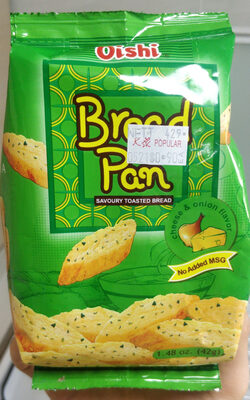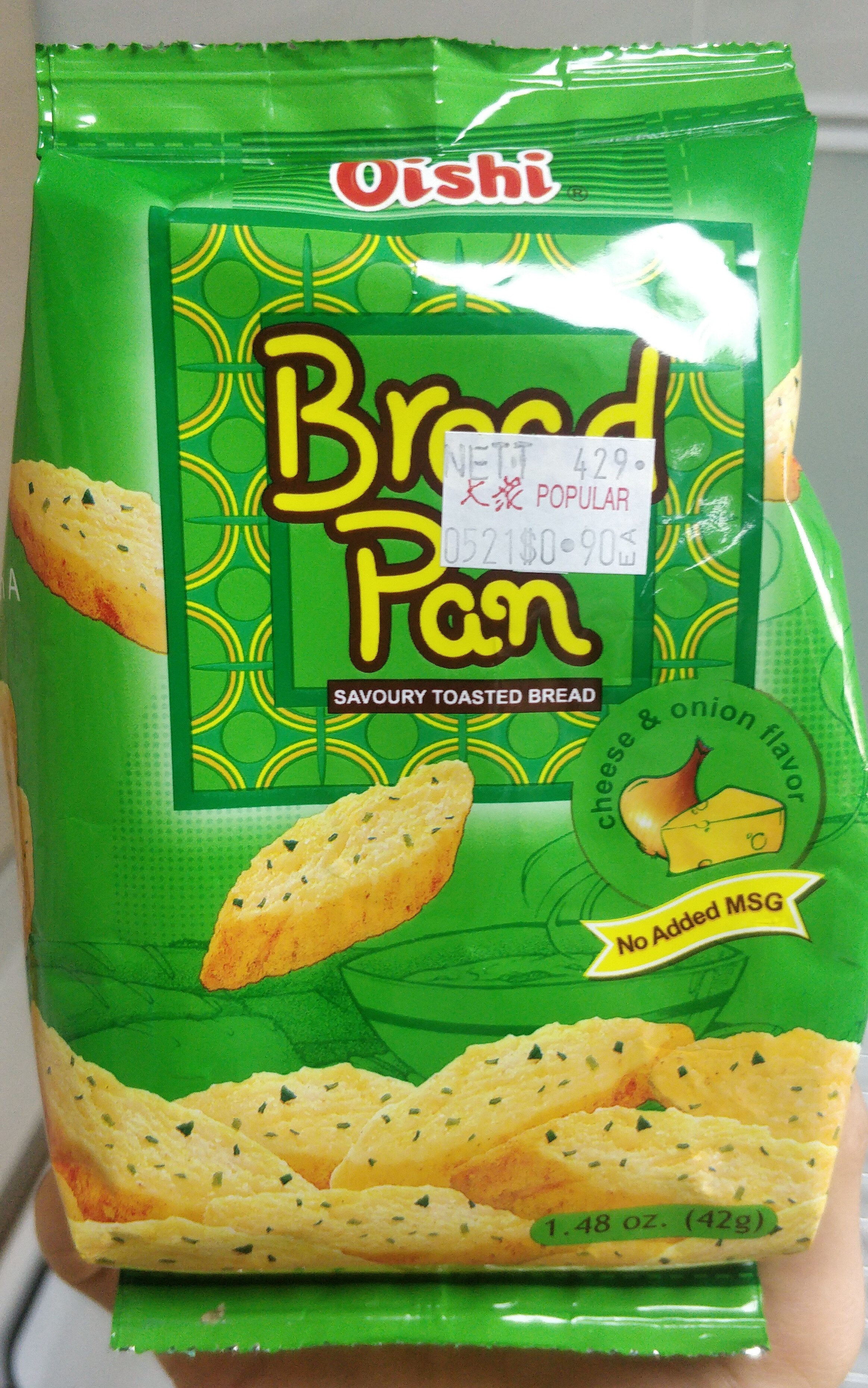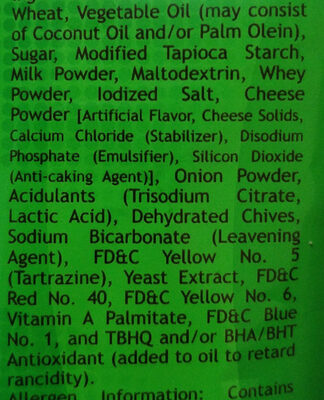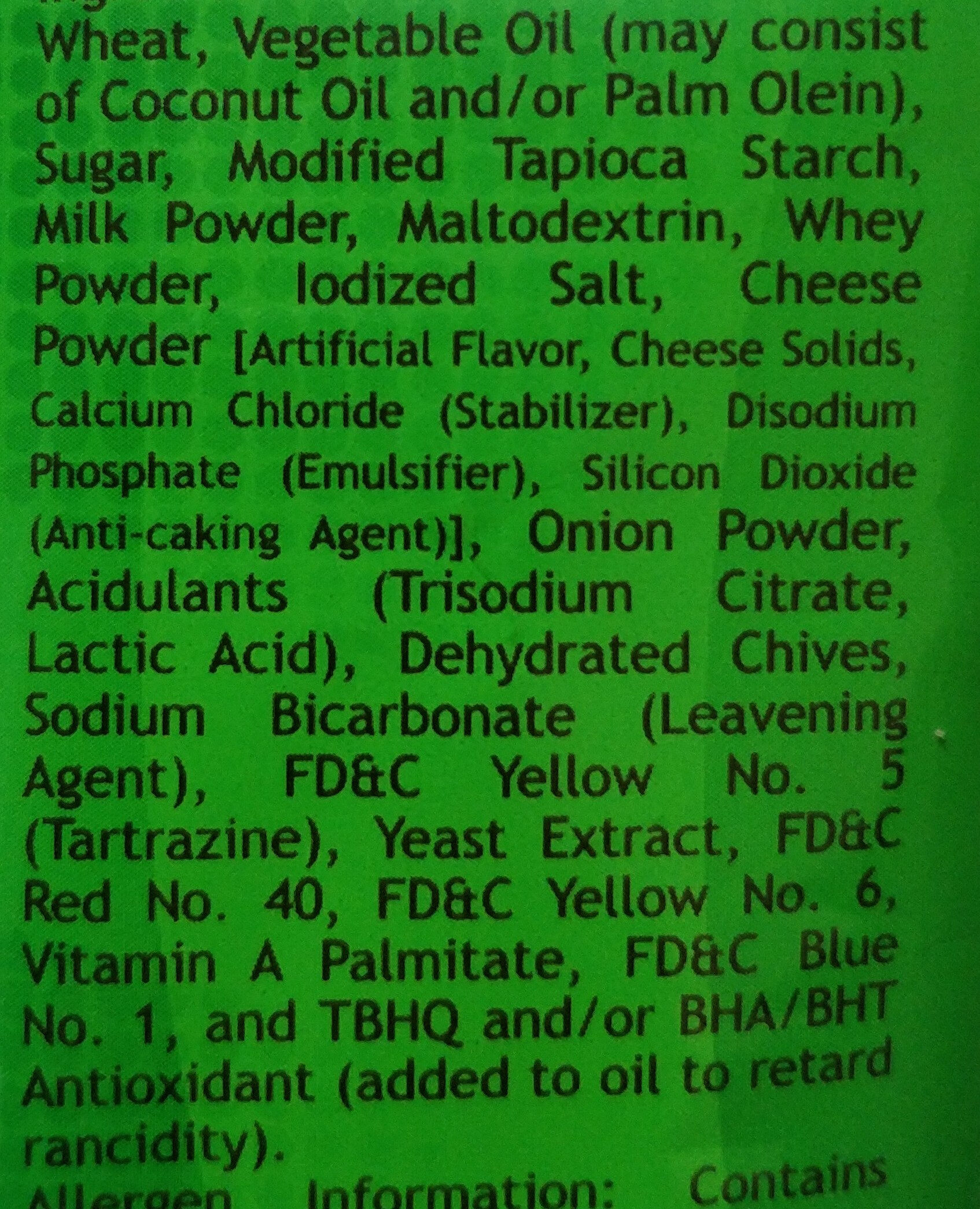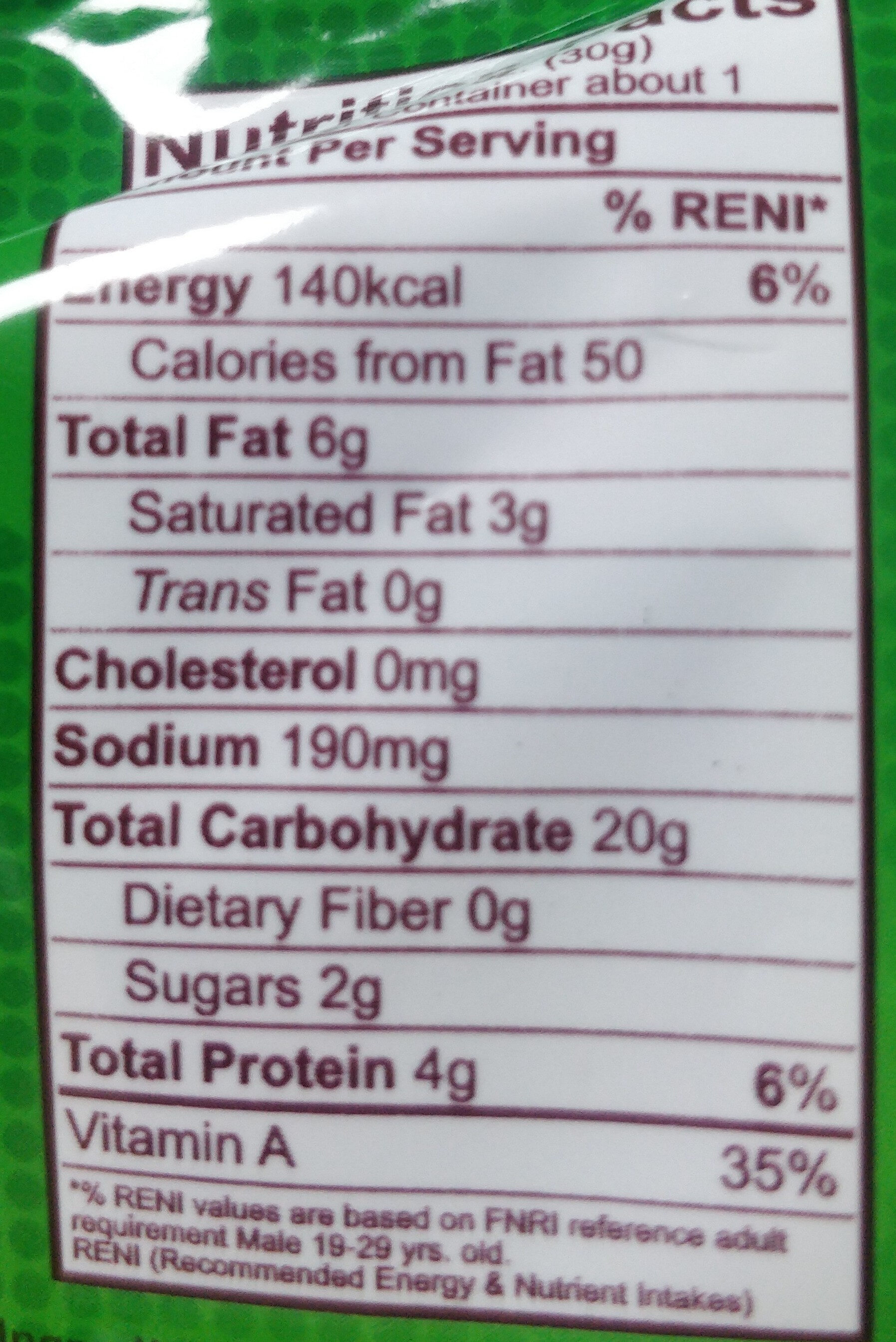Help us make food transparency the norm!
As a non-profit organization, we depend on your donations to continue informing consumers around the world about what they eat.
The food revolution starts with you!
Bread Pan - Oishi - 42 g
Bread Pan - Oishi - 42 g
This product page is not complete. You can help to complete it by editing it and adding more data from the photos we have, or by taking more photos using the app for Android or iPhone/iPad. Thank you!
×
Barcode: 4800194173223 (EAN / EAN-13)
Quantity: 42 g
Packaging: Bag plastic
Brands: Oishi
Categories: Plant-based foods and beverages, Plant-based foods, Cereals and potatoes, Breads, Toasts, Toasted bread rolls
Labels, certifications, awards: No added MSG
Manufacturing or processing places: Philippines
Matching with your preferences
Health
Ingredients
-
37 ingredients
Wheat, Vegetable Oil (Coconut Oil, Palm Olein), Sugar, Modified Tapioca Starch, Milk Powder, Maltodextrin, Whey Powder, Powder (Artificial Flavor, Cheese Solids, Calcium Chloride, Disodium Phosphate, Silicon Dioxide), Onion Powder, Acidulants, lodized Salt, Cheese (Trisodium Citrate, Lactic Acid), Dehydrated Chives, Sodium Bicarbonate, FD&C Yellow No. 5 (Tartrazine), Yeast Extract, FD&C Red No. 40, FD&C Yellow No. 6, Vitamin A Palmitate, FD&C Blue No. 1, TBHQ, BHA/BHT AntioxidantAllergens: Gluten, Milk
Food processing
-
Ultra processed foods
Elements that indicate the product is in the 4 - Ultra processed food and drink products group:
- Additive: E102 - Tartrazine
- Ingredient: Flavouring
- Ingredient: Maltodextrin
- Ingredient: Whey
Food products are classified into 4 groups according to their degree of processing:
- Unprocessed or minimally processed foods
- Processed culinary ingredients
- Processed foods
- Ultra processed foods
The determination of the group is based on the category of the product and on the ingredients it contains.
Additives
-
E102 - Tartrazine
Tartrazine: Tartrazine is a synthetic lemon yellow azo dye primarily used as a food coloring. It is also known as E number E102, C.I. 19140, FD&C Yellow 5, Acid Yellow 23, Food Yellow 4, and trisodium 1--4-sulfonatophenyl--4--4-sulfonatophenylazo--5-pyrazolone-3-carboxylate-.Tartrazine is a commonly used color all over the world, mainly for yellow, and can also be used with Brilliant Blue FCF -FD&C Blue 1, E133- or Green S -E142- to produce various green shades.Source: Wikipedia
-
E270 - Lactic acid
Lactic acid: Lactic acid is an organic compound with the formula CH3CH-OH-COOH. In its solid state, it is white and water-soluble. In its liquid state, it is colorless. It is produced both naturally and synthetically. With a hydroxyl group adjacent to the carboxyl group, lactic acid is classified as an alpha-hydroxy acid -AHA-. In the form of its conjugate base called lactate, it plays a role in several biochemical processes. In solution, it can ionize a proton from the carboxyl group, producing the lactate ion CH3CH-OH-CO−2. Compared to acetic acid, its pKa is 1 unit less, meaning lactic acid deprotonates ten times more easily than acetic acid does. This higher acidity is the consequence of the intramolecular hydrogen bonding between the α-hydroxyl and the carboxylate group. Lactic acid is chiral, consisting of two optical isomers. One is known as L--+--lactic acid or -S--lactic acid and the other, its mirror image, is D--−--lactic acid or -R--lactic acid. A mixture of the two in equal amounts is called DL-lactic acid, or racemic lactic acid. Lactic acid is hygroscopic. DL-lactic acid is miscible with water and with ethanol above its melting point which is around 17 or 18 °C. D-lactic acid and L-lactic acid have a higher melting point. In animals, L-lactate is constantly produced from pyruvate via the enzyme lactate dehydrogenase -LDH- in a process of fermentation during normal metabolism and exercise. It does not increase in concentration until the rate of lactate production exceeds the rate of lactate removal, which is governed by a number of factors, including monocarboxylate transporters, concentration and isoform of LDH, and oxidative capacity of tissues. The concentration of blood lactate is usually 1–2 mM at rest, but can rise to over 20 mM during intense exertion and as high as 25 mM afterward. In addition to other biological roles, L-lactic acid is the primary endogenous agonist of hydroxycarboxylic acid receptor 1 -HCA1-, which is a Gi/o-coupled G protein-coupled receptor -GPCR-.In industry, lactic acid fermentation is performed by lactic acid bacteria, which convert simple carbohydrates such as glucose, sucrose, or galactose to lactic acid. These bacteria can also grow in the mouth; the acid they produce is responsible for the tooth decay known as caries. In medicine, lactate is one of the main components of lactated Ringer's solution and Hartmann's solution. These intravenous fluids consist of sodium and potassium cations along with lactate and chloride anions in solution with distilled water, generally in concentrations isotonic with human blood. It is most commonly used for fluid resuscitation after blood loss due to trauma, surgery, or burns.Source: Wikipedia
-
E319 - Tertiary-butylhydroquinone (tbhq)
Tert-Butylhydroquinone: tert-Butylhydroquinone -TBHQ, tertiary butylhydroquinone- is a synthetic aromatic organic compound which is a type of phenol. It is a derivative of hydroquinone, substituted with a tert-butyl group.Source: Wikipedia
-
E320 - Butylated hydroxyanisole (bha)
Butylated hydroxyanisole: Butylated hydroxyanisole -BHA- is an antioxidant consisting of a mixture of two isomeric organic compounds, 2-tert-butyl-4-hydroxyanisole and 3-tert-butyl-4-hydroxyanisole. It is prepared from 4-methoxyphenol and isobutylene. It is a waxy solid used as a food additive with the E number E320. The primary use for BHA is as an antioxidant and preservative in food, food packaging, animal feed, cosmetics, rubber, and petroleum products. BHA also is commonly used in medicines, such as isotretinoin, lovastatin, and simvastatin, among others.Source: Wikipedia
-
E331 - Sodium citrates
Sodium citrate: Sodium citrate may refer to any of the sodium salts of citrate -though most commonly the third-: Monosodium citrate Disodium citrate Trisodium citrateThe three forms of the salt are collectively known by the E number E331. Sodium citrates are used as acidity regulators in food and drinks, and also as emulsifiers for oils. They enable cheeses to melt without becoming greasy.Source: Wikipedia
-
E331iii - Trisodium citrate
Sodium citrate: Sodium citrate may refer to any of the sodium salts of citrate -though most commonly the third-: Monosodium citrate Disodium citrate Trisodium citrateThe three forms of the salt are collectively known by the E number E331. Sodium citrates are used as acidity regulators in food and drinks, and also as emulsifiers for oils. They enable cheeses to melt without becoming greasy.Source: Wikipedia
-
E339ii - Disodium phosphate
Sodium phosphates: Sodium phosphate is a generic term for a variety of salts of sodium -Na+- and phosphate -PO43−-. Phosphate also forms families or condensed anions including di-, tri-, tetra-, and polyphosphates. Most of these salts are known in both anhydrous -water-free- and hydrated forms. The hydrates are more common than the anhydrous forms.Source: Wikipedia
-
E500 - Sodium carbonates
Sodium carbonates (E500) are compounds commonly used in food preparation as leavening agents, helping baked goods rise by releasing carbon dioxide when they interact with acids.
Often found in baking soda, they regulate the pH of food, preventing it from becoming too acidic or too alkaline. In the culinary world, sodium carbonates can also enhance the texture and structure of foods, such as noodles, by modifying the gluten network.
Generally recognized as safe, sodium carbonates are non-toxic when consumed in typical amounts found in food.
-
E500ii - Sodium hydrogen carbonate
Sodium hydrogen carbonate, also known as E500ii, is a food additive commonly used as a leavening agent.
When added to recipes, it releases carbon dioxide gas upon exposure to heat or acids, causing dough to rise and resulting in a light, fluffy texture in baked goods.
It is generally recognized as safe (GRAS) by regulatory authorities when used in appropriate quantities and poses no significant health risks when consumed in typical food applications.
Ingredients analysis
-
Palm oil
Ingredients that contain palm oil: Palm olein
-
Non-vegan
Non-vegan ingredients: Milk powder, Whey powder, Cheese, CheeseSome ingredients could not be recognized.
We need your help!
You can help us recognize more ingredients and better analyze the list of ingredients for this product and others:
- Edit this product page to correct spelling mistakes in the ingredients list, and/or to remove ingredients in other languages and sentences that are not related to the ingredients.
- Add new entries, synonyms or translations to our multilingual lists of ingredients, ingredient processing methods, and labels.
If you would like to help, join the #ingredients channel on our Slack discussion space and/or learn about ingredients analysis on our wiki. Thank you!
-
Vegetarian status unknown
Unrecognized ingredients: Powder, E339ii, Lodized-salt, Fd-c-yellow-no, 5, Fd-c-red-no, 40, Fd-c-yellow-no, 6, Fd-c-blue-no, 1, Bht-antioxidantSome ingredients could not be recognized.
We need your help!
You can help us recognize more ingredients and better analyze the list of ingredients for this product and others:
- Edit this product page to correct spelling mistakes in the ingredients list, and/or to remove ingredients in other languages and sentences that are not related to the ingredients.
- Add new entries, synonyms or translations to our multilingual lists of ingredients, ingredient processing methods, and labels.
If you would like to help, join the #ingredients channel on our Slack discussion space and/or learn about ingredients analysis on our wiki. Thank you!
-
Details of the analysis of the ingredients
We need your help!
Some ingredients could not be recognized.
We need your help!
You can help us recognize more ingredients and better analyze the list of ingredients for this product and others:
- Edit this product page to correct spelling mistakes in the ingredients list, and/or to remove ingredients in other languages and sentences that are not related to the ingredients.
- Add new entries, synonyms or translations to our multilingual lists of ingredients, ingredient processing methods, and labels.
If you would like to help, join the #ingredients channel on our Slack discussion space and/or learn about ingredients analysis on our wiki. Thank you!
: _Wheat_, Vegetable Oil (Coconut Oil, Palm Olein), Sugar, Modified Tapioca Starch, _Milk_ Powder, Maltodextrin, Whey Powder, Powder (Artificial Flavor, Cheese, Calcium Chloride, Disodium Phosphate, Silicon Dioxide), Onion, Acidulants, lodized Salt, Cheese (Trisodium Citrate, Lactic Acid), Chives, Sodium Bicarbonate, FD&C Yellow No, 5 (Tartrazine), Yeast Extract, FD&C Red No, 40, FD&C Yellow No, 6, Vitamin A Palmitate, FD&C Blue No, 1, TBHQ, BHA, BHT Antioxidant- _Wheat_ -> en:wheat - vegan: yes - vegetarian: yes - ciqual_proxy_food_code: 9410 - percent_min: 3.7037037037037 - percent_max: 100
- Vegetable Oil -> en:vegetable-oil - vegan: yes - vegetarian: yes - from_palm_oil: maybe - percent_min: 0 - percent_max: 50
- Coconut Oil -> en:coconut-oil - vegan: yes - vegetarian: yes - from_palm_oil: no - ciqual_food_code: 16040 - percent_min: 0 - percent_max: 50
- Palm Olein -> en:palm-olein - vegan: yes - vegetarian: yes - from_palm_oil: yes - ciqual_food_code: 16129 - percent_min: 0 - percent_max: 25
- Sugar -> en:sugar - vegan: yes - vegetarian: yes - ciqual_proxy_food_code: 31016 - percent_min: 0 - percent_max: 6.67
- Modified Tapioca Starch -> en:modified-tapioca-starch - vegan: yes - vegetarian: yes - ciqual_proxy_food_code: 9510 - percent_min: 0 - percent_max: 6.67
- _Milk_ Powder -> en:milk-powder - vegan: no - vegetarian: yes - ciqual_proxy_food_code: 19044 - percent_min: 0 - percent_max: 6.67
- Maltodextrin -> en:maltodextrin - vegan: yes - vegetarian: yes - percent_min: 0 - percent_max: 6.67
- Whey Powder -> en:whey-powder - vegan: no - vegetarian: maybe - percent_min: 0 - percent_max: 6.67
- Powder -> en:powder - percent_min: 0 - percent_max: 6.67
- Artificial Flavor -> en:artificial-flavouring - vegan: maybe - vegetarian: maybe - percent_min: 0 - percent_max: 6.67
- Cheese -> en:cheese - vegan: no - vegetarian: maybe - ciqual_proxy_food_code: 12999 - percent_min: 0 - percent_max: 3.335
- Calcium Chloride -> en:e509 - vegan: yes - vegetarian: yes - percent_min: 0 - percent_max: 2.22333333333333
- Disodium Phosphate -> en:e339ii - percent_min: 0 - percent_max: 1.6675
- Silicon Dioxide -> en:e551 - vegan: yes - vegetarian: yes - percent_min: 0 - percent_max: 1.334
- Onion -> en:onion - vegan: yes - vegetarian: yes - ciqual_food_code: 20034 - percent_min: 0 - percent_max: 6.67
- Acidulants -> en:acid - percent_min: 0 - percent_max: 6.67
- lodized Salt -> en:lodized-salt - percent_min: 0 - percent_max: 6.67
- Cheese -> en:cheese - vegan: no - vegetarian: maybe - ciqual_proxy_food_code: 12999 - percent_min: 0 - percent_max: 6.67
- Trisodium Citrate -> en:e331iii - vegan: yes - vegetarian: yes - percent_min: 0 - percent_max: 6.67
- Lactic Acid -> en:e270 - vegan: yes - vegetarian: yes - percent_min: 0 - percent_max: 3.335
- Chives -> en:chives - vegan: yes - vegetarian: yes - ciqual_food_code: 11003 - percent_min: 0 - percent_max: 6.67
- Sodium Bicarbonate -> en:e500ii - vegan: yes - vegetarian: yes - percent_min: 0 - percent_max: 6.67
- FD&C Yellow No -> en:fd-c-yellow-no - percent_min: 0 - percent_max: 6.67
- 5 -> en:5 - percent_min: 0 - percent_max: 6.25
- Tartrazine -> en:e102 - vegan: yes - vegetarian: yes - percent_min: 0 - percent_max: 6.25
- Yeast Extract -> en:yeast-extract - vegan: yes - vegetarian: yes - percent_min: 0 - percent_max: 5.88235294117647
- FD&C Red No -> en:fd-c-red-no - percent_min: 0 - percent_max: 5.55555555555556
- 40 -> en:40 - percent_min: 0 - percent_max: 5.26315789473684
- FD&C Yellow No -> en:fd-c-yellow-no - percent_min: 0 - percent_max: 5
- 6 -> en:6 - percent_min: 0 - percent_max: 4.76190476190476
- Vitamin A Palmitate -> en:retinyl-palmitate - vegan: yes - vegetarian: yes - percent_min: 0 - percent_max: 4.54545454545455
- FD&C Blue No -> en:fd-c-blue-no - percent_min: 0 - percent_max: 4.34782608695652
- 1 -> en:1 - percent_min: 0 - percent_max: 4.16666666666667
- TBHQ -> en:e319 - vegan: yes - vegetarian: yes - percent_min: 0 - percent_max: 4
- BHA -> en:e320 - vegan: yes - vegetarian: yes - percent_min: 0 - percent_max: 3.84615384615385
- BHT Antioxidant -> en:bht-antioxidant - percent_min: 0 - percent_max: 3.7037037037037
Nutrition
-
Bad nutritional quality
⚠ ️Warning: the amount of fruits, vegetables and nuts is not specified on the label, it was estimated from the list of ingredients: 0This product is not considered a beverage for the calculation of the Nutri-Score.
Positive points: 0
- Proteins: 5 / 5 (value: 13.3, rounded value: 13.3)
- Fiber: 0 / 5 (value: 0, rounded value: 0)
- Fruits, vegetables, nuts, and colza/walnut/olive oils: 0 / 5 (value: 0.127002314814817, rounded value: 0.1)
Negative points: 22
- Energy: 5 / 10 (value: 1950, rounded value: 1950)
- Sugars: 1 / 10 (value: 6.67, rounded value: 6.67)
- Saturated fat: 9 / 10 (value: 10, rounded value: 10)
- Sodium: 7 / 10 (value: 643, rounded value: 643)
The points for proteins are not counted because the negative points are greater or equal to 11.
Nutritional score: (22 - 0)
Nutri-Score:
-
Nutrient levels
-
Fat in moderate quantity (20%)
What you need to know- A high consumption of fat, especially saturated fats, can raise cholesterol, which increases the risk of heart diseases.
Recommendation: Limit the consumption of fat and saturated fat- Choose products with lower fat and saturated fat content.
-
Saturated fat in high quantity (10%)
What you need to know- A high consumption of fat, especially saturated fats, can raise cholesterol, which increases the risk of heart diseases.
Recommendation: Limit the consumption of fat and saturated fat- Choose products with lower fat and saturated fat content.
-
Sugars in moderate quantity (6.67%)
What you need to know- A high consumption of sugar can cause weight gain and tooth decay. It also augments the risk of type 2 diabetes and cardio-vascular diseases.
Recommendation: Limit the consumption of sugar and sugary drinks- Sugary drinks (such as sodas, fruit beverages, and fruit juices and nectars) should be limited as much as possible (no more than 1 glass a day).
- Choose products with lower sugar content and reduce the consumption of products with added sugars.
-
Salt in high quantity (1.61%)
What you need to know- A high consumption of salt (or sodium) can cause raised blood pressure, which can increase the risk of heart disease and stroke.
- Many people who have high blood pressure do not know it, as there are often no symptoms.
- Most people consume too much salt (on average 9 to 12 grams per day), around twice the recommended maximum level of intake.
Recommendation: Limit the consumption of salt and salted food- Reduce the quantity of salt used when cooking, and don't salt again at the table.
- Limit the consumption of salty snacks and choose products with lower salt content.
-
-
Nutrition facts
Nutrition facts As sold
for 100 g / 100 mlAs sold
per serving (30g)Compared to: Toasted bread rolls Energy 1,950 kj
(467 kcal)586 kj
(140 kcal)+20% Fat 20 g 6 g +142% Saturated fat 10 g 3 g +630% Trans fat 0 g 0 g Carbohydrates 66.7 g 20 g +5% Sugars 6.67 g 2 g +33% Fiber 0 g 0 g -100% Proteins 13.3 g 4 g +28% Salt 1.61 g 0.483 g +40% Fruits‚ vegetables‚ nuts and rapeseed‚ walnut and olive oils (estimate from ingredients list analysis) 0.127 % 0.127 %
Environment
-
Eco-Score B - Low environmental impact
⚠ ️Select a country in order to include the full impact of transportation.The Eco-Score is an experimental score that summarizes the environmental impacts of food products.→ The Eco-Score was initially developped for France and it is being extended to other European countries. The Eco-Score formula is subject to change as it is regularly improved to make it more precise and better suited to each country.Life cycle analysis
-
Average impact of products of the same category: A (Score: 92/100)
Category: Wheat swedish toast
Category: Wheat swedish toast
- PEF environmental score: 0.18 (the lower the score, the lower the impact)
- including impact on climate change: 1.27 kg CO2 eq/kg of product
Stage Impact Agriculture
66.6 %Processing
20.6 %Packaging
6.1 %Transportation
6.3 %Distribution
0.4 %Consumption
0.0 %
Bonuses and maluses
-
Missing origins of ingredients information
Malus: -5
⚠ ️ The origins of the ingredients of this product are not indicated.
If they are indicated on the packaging, you can modify the product sheet and add them.
If you are the manufacturer of this product, you can send us the information with our free platform for producers.
-
Ingredients that threatens species
Malus: -10
Contains palm oil
Tropical forests in Asia, Africa and Latin America are destroyed to create and expand oil palm tree plantations. The deforestation contributes to climate change, and it endangers species such as the orangutan, the pigmy elephant and the Sumatran rhino.
-
Packaging with a medium impact
Malus: -10
Shape Material Recycling Impact Bag Plastic High
Eco-Score for this product
-
Impact for this product: B (Score: 67/100)
Product: Bread Pan - Oishi - 42 g
Life cycle analysis score: 92
Sum of bonuses and maluses: -25
Final score: 67/100
-
Carbon footprint
-
Equal to driving 0.7 km in a petrol car
127 g CO² per 100g of product
The carbon emission figure comes from ADEME's Agribalyse database, for the category: Wheat swedish toast (Source: ADEME Agribalyse Database)
Stage Impact Agriculture
64.8 %Processing
15.4 %Packaging
8.7 %Transportation
10.8 %Distribution
0.4 %Consumption
0.0 %
Packaging
-
Packaging with a medium impact
-
Packaging parts
Bag (Plastic)
-
Packaging materials
Material % Packaging weight Packaging weight per 100 g of product Plastic
-
Transportation
-
Origins of ingredients
Missing origins of ingredients information
⚠ ️ The origins of the ingredients of this product are not indicated.
If they are indicated on the packaging, you can modify the product sheet and add them.
If you are the manufacturer of this product, you can send us the information with our free platform for producers.Add the origins of ingredients for this product Add the origins of ingredients for this product
Threatened species
-
Contains palm oil
Drives deforestation and threatens species such as the orangutan
Tropical forests in Asia, Africa and Latin America are destroyed to create and expand oil palm tree plantations. The deforestation contributes to climate change, and it endangers species such as the orangutan, the pigmy elephant and the Sumatran rhino.
Report a problem
-
Incomplete or incorrect information?
Category, labels, ingredients, allergens, nutritional information, photos etc.
If the information does not match the information on the packaging, please complete or correct it. Open Food Facts is a collaborative database, and every contribution is useful for all.
Data sources
Product added on by ibwocoruytrc
Last edit of product page on by ecoscore-impact-estimator.
Product page also edited by openfoodfacts-contributors, packbot.
